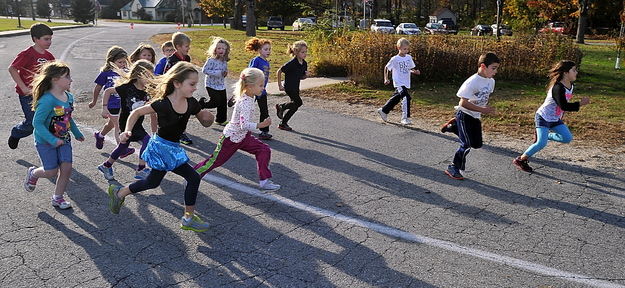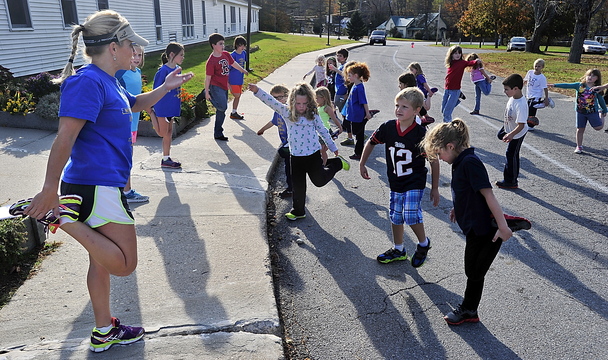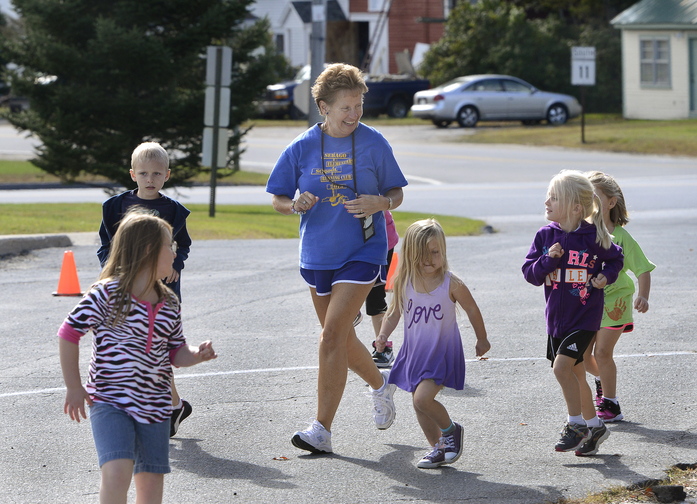The latest tool for getting young children active is running, and all it takes is a pair of sneakers.
Running clubs for elementary school students are taking off around Maine, boosted by a rapidly expanding Girls on the Run program for third- through fifth-graders and by enthusiastic teachers who are starting informal after-school programs to share their passion for running.
The national nonprofit Girls on the Run opened its first Maine chapter last fall with 12 girls at Portland’s Longfellow Elementary School. This fall, more than 160 girls are signed up at elementary schools in the Portland area.
“What’s cool about it is that if you’ve had a bit of a bad day or something, you can come here and it makes you feel good,” said Sydney Hews, a fifth-grader who is part of Girls on the Run at South Portland’s Dyer Elementary School. “You can come in feeling like you’re in a ditch and then you go run and you feel good and strong.”
Girls on the Run clubs are operating at the Dyer school in South Portland, Great Falls Elementary School in Gorham, Falmouth Elementary School, Longfellow and Ocean Avenue elementary schools in Portland, Pond Cove Elementary School in Cape Elizabeth, Yarmouth Elementary School and the Casco Bay YMCA in Freeport.
Nationally, a range of programs have begun in recent years in response to reports of rising rates of childhood obesity, from first lady Michelle Obama’s Let’s Move program to the Portland-based Let’s Go program, which has expanded beyond the state. They combine dietary advice, physical activity guidelines and recommendations for teaching children about good health.
According to 2010 census figures, 14 percent of 5- to 9-year-olds and 14.5 percent of 10- to 14-year-olds in Maine are obese.
Experts have long urged students to get at least 60 minutes of physical activity a day, but organized school sports aren’t widely offered until middle school and high school, so the running programs are important at the elementary school level, organizers say.
“I love seeing the girls and what it does for them,” said Martha Bolduc, a second-grade teacher at the Dyer school who leads a Girls on the Run club.
Working with girls in third, fourth and fifth grades is important because that’s usually the age when they start shifting from listening to their parents’ opinions to their peers’ opinions. As part of the program, the girls do team exercises led by a teacher, talk about healthy habits and how to be a good friend, and how to empower themselves and others.
“You have to always be positive,” said Tess Tifft, 10, a fifth-grader at Dyer. “Like when you’re passing someone (when you’re running), you call out ‘You’re doing great!’ or ‘Good job!’ ”
Exact numbers of elementary school running programs in Maine are hard to come by, because many operate informally or are after-school programs led by volunteers. Joe Boucher, the physical activity and nutrition consultant for the state Department of Education, said he has heard of several around the state.
“More and more, there’s a lot of interest in physical activity, especially in the last few years,” he said.
Three years ago, the department analyzed the level of physical education in the state and found that the average elementary school student got about 40 minutes, in one or two days a week.
The state doesn’t require a minimum number of physical education classes for schools, so districts can set their own policies, Boucher said. The National Association of Sport and Physical Education recommends 150 minutes of physical education a week for elementary school students, and 225 minutes a week for middle and high school students, for the entire school year.
Portland schools’ requirements don’t even reach that goal halfway: All elementary school children get 45 minutes of physical education a week. Deering High School offers 75 minutes a week for half of the year; Portland High requires 80 minutes a week for the entire year.
“I think everybody understands that it’s going to be hard to give every student 60 minutes every day,” said Boucher, who works with districts to connect them with resources to enhance their physical education programs. “Anything we can do to get kids moving is good.”
In addition to health benefits, many studies show exercise has academic benefits, he said. This week, a British study of 11-year-olds showed that the more active they were, the better they did on standardized tests of English, math and science.
KIDS LEARNING ABOUT THEIR BODIES
At Sebago Elementary School, fifth-grade teacher Kimberly Kelly started a running club last year that includes more than half of the 83 students. She said the school bus driver jokes about how empty the bus is on days when the students go running.
Kelly said she started the club because a teacher got her hooked on running when she was just 8. “I realized what I had as a little girl could happen at my school, but there wasn’t a program,” said Kelly, 42.
She and a few other teachers started the club last spring with 25 runners. This year, 42 students come out twice a week to run around the school grounds and fields.
“The kids are enjoying it and they’re moving,” said Kelly. “They’re learning so much about their bodies.”
They’re also seeing improvement: One first-grader who couldn’t finish a single lap when she started can now run a full mile, Kelly said. Three students have run 5-kilometer races – and won medals. One 9-year-old student is running 5Ks in about 26 minutes.
Congin Elementary School in Westbrook used to have a walking club, in which students walked during recess and earned prizes and tracked their progress as a school. For some, it turned into a running club just because that’s how they chose to do it, said Andrea Stultz, a fourth-grade teacher.
“I loved it, I liked how it motivated the kids,” said Stultz, but the club ended when there was a change in guidance counselors. “These kids could stare at a screen all day, which is what I fear would happen if they didn’t have other interests.”
benefits beyond healthy exercise
Jennifer Cohen said her 9-year-old daughter, Anna, has become a dedicated runner since joining a lunchtime running club at Coastal Ridge Elementary School in York. The students run a mile, doing laps around a track and earning prizes and special events when they hit key goals.
“She’s totally gotten into running because of it,” Cohen said.
Anna ran 127 miles last year as a third-grader, getting a T-shirt at 50 miles and an ice cream party at 100 miles. “The fact is, my kid’s favorite thing to do is run around the track at lunch … they love it,” Cohen said.
Running also gets her moving, even on the weekends, and has increased her stamina for soccer. She’s now confident enough to try out for new sports, Cohen said.
Dr. Joel Brenner, chairman of the American Academy of Pediatrics’ Council on Sports Medicine and Fitness, said running is a good starter sport because it requires only a pair of shoes and is something that families can do together. Several of the girls at the Dyer school said they started running with their parents, who are runners.
Running can also be empowering and help children set goals for themselves, said Sandi Sinclair, development and marketing coordinator for Girls on the Run in Maine. The program, which costs $129 per girl for the season, culminates with a fun run 5K.
“Seeing the looks on their faces, it’s awesome,” Sinclair said. “A lot of these girls have never run before, so the idea of completing a 5K seems so unattainable.”
Noel K. Gallagher can be contacted at 791-6387 or at:
ngallagher@pressherald.com
Send questions/comments to the editors.






